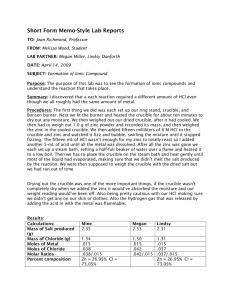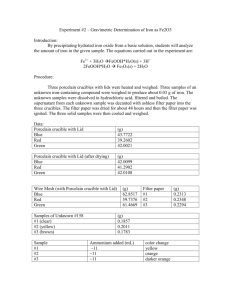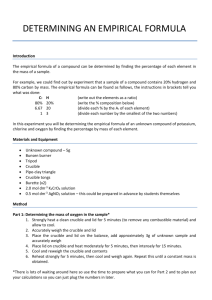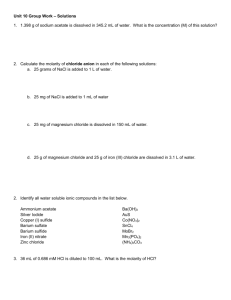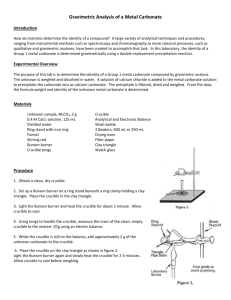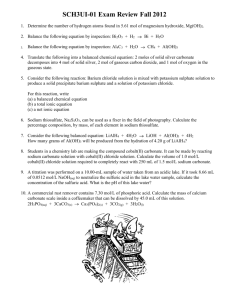Lab 4 - Chemical formula of carbonate
advertisement
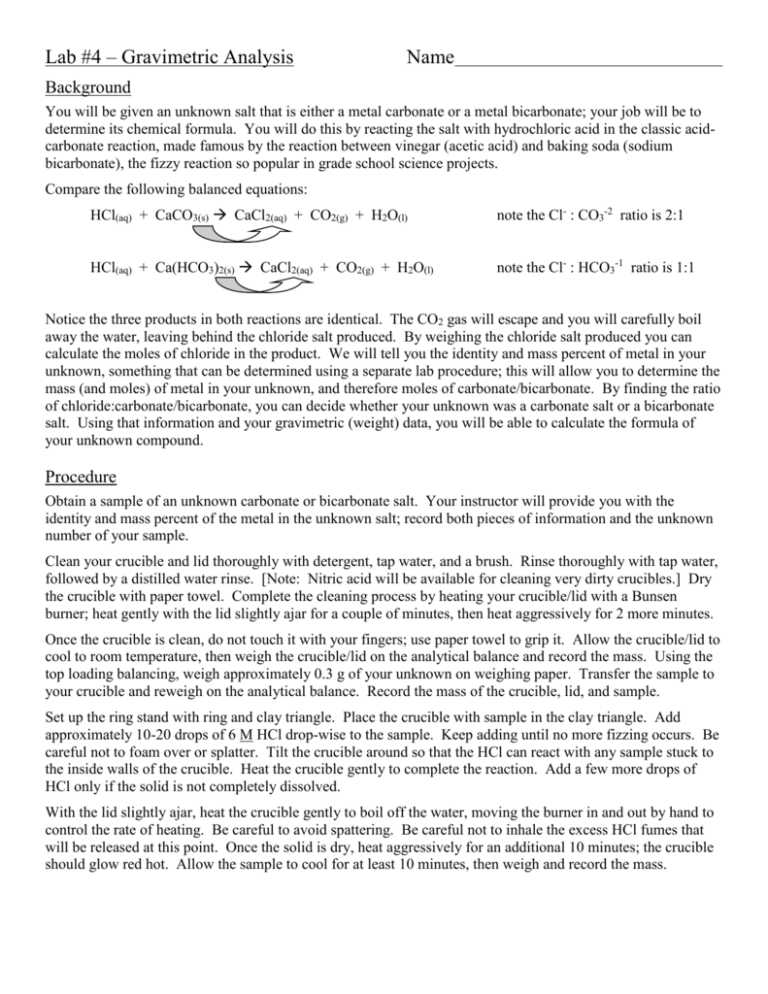
Lab #4 – Gravimetric Analysis Name Background You will be given an unknown salt that is either a metal carbonate or a metal bicarbonate; your job will be to determine its chemical formula. You will do this by reacting the salt with hydrochloric acid in the classic acidcarbonate reaction, made famous by the reaction between vinegar (acetic acid) and baking soda (sodium bicarbonate), the fizzy reaction so popular in grade school science projects. Compare the following balanced equations: HCl(aq) + CaCO3(s) CaCl2(aq) + CO2(g) + H2O(l) note the Cl- : CO3-2 ratio is 2:1 HCl(aq) + Ca(HCO3)2(s) CaCl2(aq) + CO2(g) + H2O(l) note the Cl- : HCO3-1 ratio is 1:1 Notice the three products in both reactions are identical. The CO2 gas will escape and you will carefully boil away the water, leaving behind the chloride salt produced. By weighing the chloride salt produced you can calculate the moles of chloride in the product. We will tell you the identity and mass percent of metal in your unknown, something that can be determined using a separate lab procedure; this will allow you to determine the mass (and moles) of metal in your unknown, and therefore moles of carbonate/bicarbonate. By finding the ratio of chloride:carbonate/bicarbonate, you can decide whether your unknown was a carbonate salt or a bicarbonate salt. Using that information and your gravimetric (weight) data, you will be able to calculate the formula of your unknown compound. Procedure Obtain a sample of an unknown carbonate or bicarbonate salt. Your instructor will provide you with the identity and mass percent of the metal in the unknown salt; record both pieces of information and the unknown number of your sample. Clean your crucible and lid thoroughly with detergent, tap water, and a brush. Rinse thoroughly with tap water, followed by a distilled water rinse. [Note: Nitric acid will be available for cleaning very dirty crucibles.] Dry the crucible with paper towel. Complete the cleaning process by heating your crucible/lid with a Bunsen burner; heat gently with the lid slightly ajar for a couple of minutes, then heat aggressively for 2 more minutes. Once the crucible is clean, do not touch it with your fingers; use paper towel to grip it. Allow the crucible/lid to cool to room temperature, then weigh the crucible/lid on the analytical balance and record the mass. Using the top loading balancing, weigh approximately 0.3 g of your unknown on weighing paper. Transfer the sample to your crucible and reweigh on the analytical balance. Record the mass of the crucible, lid, and sample. Set up the ring stand with ring and clay triangle. Place the crucible with sample in the clay triangle. Add approximately 10-20 drops of 6 M HCl drop-wise to the sample. Keep adding until no more fizzing occurs. Be careful not to foam over or splatter. Tilt the crucible around so that the HCl can react with any sample stuck to the inside walls of the crucible. Heat the crucible gently to complete the reaction. Add a few more drops of HCl only if the solid is not completely dissolved. With the lid slightly ajar, heat the crucible gently to boil off the water, moving the burner in and out by hand to control the rate of heating. Be careful to avoid spattering. Be careful not to inhale the excess HCl fumes that will be released at this point. Once the solid is dry, heat aggressively for an additional 10 minutes; the crucible should glow red hot. Allow the sample to cool for at least 10 minutes, then weigh and record the mass. Prelab summary Procedural Tips: Add HCl slowly to avoid foaming over and splattering. Boil off water slowly to avoid spattering. Do NOT place a hot crucible directly on a cold lab bench. Use the ceramic pad from the community drawer. Do NOT weigh a hot object on an electronic balance. You have two types of tongs and forceps at your disposal for handling labware. Choose intelligently. Safety: Use caution with 6 M HCl. Rinse hands with tap water after each use. Contact instructor immediately concerning spills. Avoid HCl fumes, especially when heating. Do NOT use excess HCl as any excess will be blown off as nasty HCl fumes later. Hot glass and ceramic ware look exactly like cold glass and ceramic ware. Treat the $2,000 analytical balance like the extremely delicate instrument it is. Disposal: All excess reagents can be rinsed down the sink with plenty of tap water. Data and Calculations UK # Metal in UK Mass % metal Mass of crucible/lid g Mass of crucible/lid and sample g Mass of sample g Mass of crucible/lid and chloride product g Mass of chloride product g Mass of metal in UK and chloride product g Moles of metal in UK and chloride product mol Mass of Cl- in chloride product g Mole of Cl- mol Mole ratio, metal:chloride in product Nearest integral mole ratio : : Mass of carbonate/bicarbonate in UK Moles, if carbonate % Formula of chloride product g mol Moles, if bicarbonate Mole ratio of chloride in product:carbonate/bicarbonate in UK mol : The UK is a carbonate bicarbonate (circle one) Mole ratio, metal:carbonate/bicarbonate in UK : Formula of UK Prelab Questions (Show ALL work) A student using this procedure collects the following data: crucible/lid = 21.462 g crucible/lid + UK = 21.787 g crucible/lid + chloride product = 21.830 g He is told his unknown carbonate/bicarbonate is 28.8% magnesium 1. Find the mass and moles of magnesium in the UK and the product. g mol 2. Find the mass of carbonate/bicarb UK and the mass of chloride product g UK g product 3. Find the mass and moles of carbonate/bicarbonate in the UK g mol 4. Find the mass and moles of chloride in the product g mol 5. Calculate the ratio of Cl- in product:carb/bicarb in UK 6. Is the unknown a carbonate or a bicarbonate? Explain. : carbonate OR bicarbonate (circle one) 7. What is the formula of the UK? 8. What is the formula of the product? 9. If some of the chloride product is lost due to spattering, how will the determination of the UK’s formula be affected? Be specific as you discuss the resulting changes in calculation.
